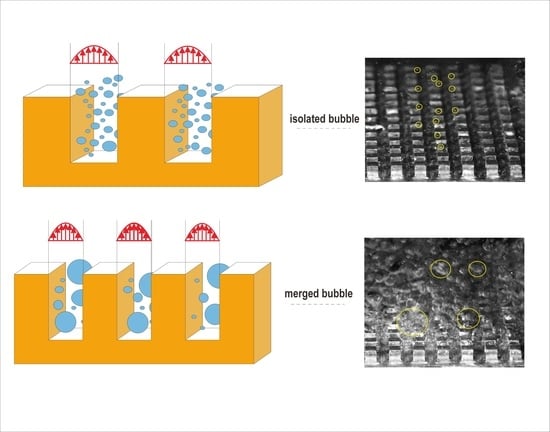The Role of Pin Fin Array Configurations and Bubble Characteristics on the Pool Boiling Heat Transfer Enhancement
Abstract
:1. Introduction
2. Experimental Methodology
2.1. Experimental Facility
2.2. Test Samples
2.3. Experimental Procedures and Uncertainty Analysis
3. Results and Discussion
3.1. Boiling Curve and Regime
3.2. Heat Transfer and Bubble Characteristics
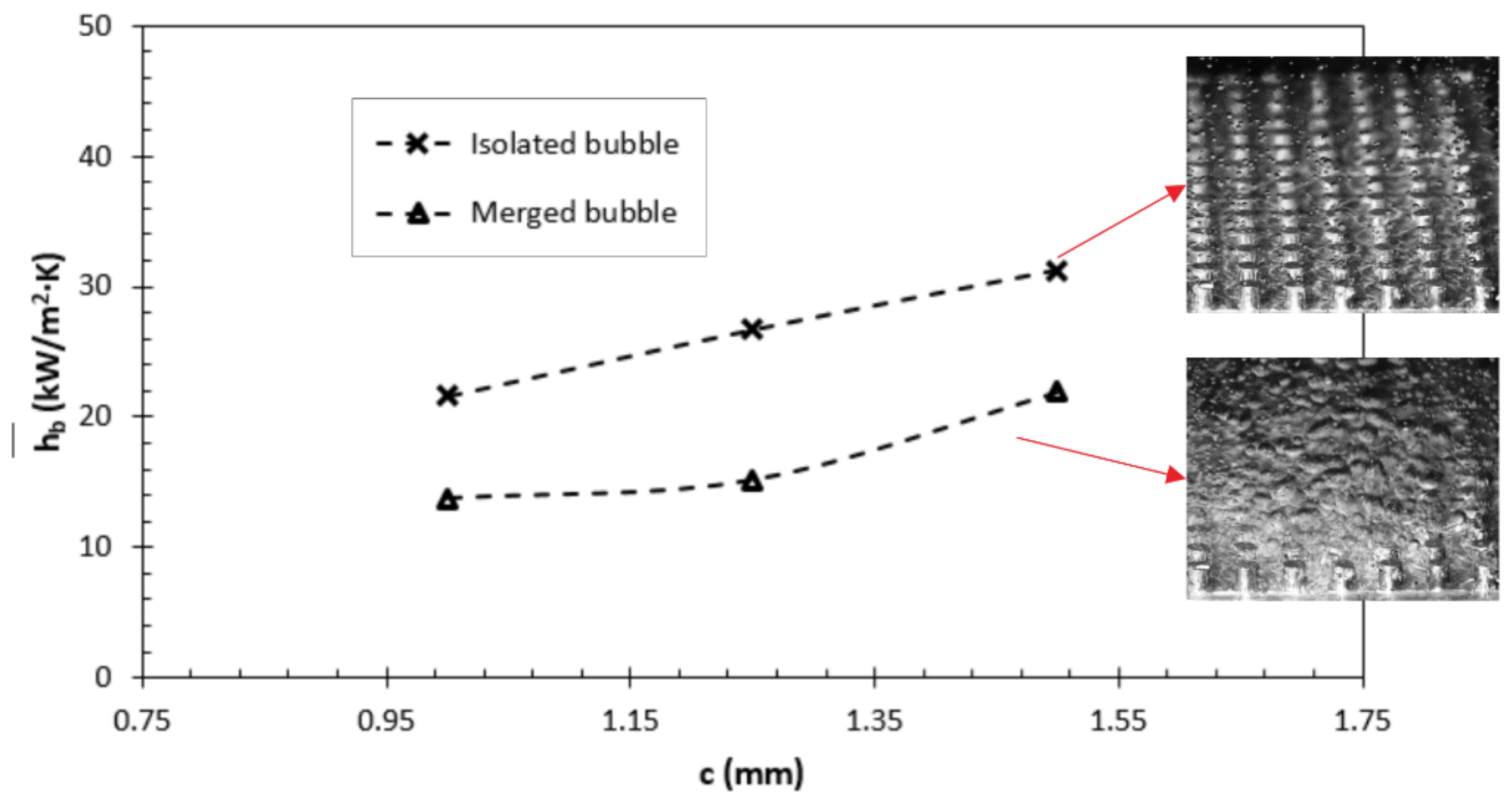

4. Conclusions
- The boiling phenomenon was observed to be in the three regimes: natural convection (Ts < Tsat), isolated bubble (0 K < Tsat < ~10 K), and merged bubble (Tsat > 10 K). Natural convection showed no bubble generation due to a lack of surface temperature. Both isolated and merged bubble regimes were within the category of nucleate boiling, but demonstrated a discrepancy in the bubble interaction before lift-off. Whilst the isolated bubble did not have any interaction among the bubbles, the merged bubble regime showed the merging process occurring on the hot surface.
- The boiling heat transfer coefficient increased as the fin gap rose. The enhancement was observed at 63.4% for the circular pin fin array, whilst the rectangular pin fin array demonstrated lower enhancement at around 17.8%. This indicates that the enhancement was more impactful in the circular pin fin, particularly at the gap between 1 mm and 1.5 mm. This discrepancy is due to the different active nucleation site densities between both shapes.
- Overall, the isolated bubble regime demonstrated better cooling performance than the merged bubble at around 56.31% and 62.31% for circular and rectangular pin fin arrays, respectively. This is due to the blanket of vapor built on the hot surface due to bubble merging. This blanket increased the thermal resistance, undermining the bubble dynamics enhancement observed in the isolated bubble regime.
- Visualization and dimensionless number demonstrated enhanced bubble dynamics as the pin fin gap rose. By increasing the gap between the fins, the buoyancy force increased whilst the flow resistance reduced. This allows the bubble to depart easier and, hence, increases the heat transfer coefficient.
- From the dimensionless number plots, it was found that the buoyancy force was more dominant than the viscous force (Gr > 1), while the Bo plot showed that the buoyancy force was more influential than the surface tension (Bo > 1). Both results indicated the priority in enhancement, whereby the buoyancy force had a strong correlation with the pin fin gap which constitutes the magnitude of characteristic length.
Author Contributions
Funding
Institutional Review Board Statement
Informed Consent Statement
Data Availability Statement
Conflicts of Interest
Nomenclature
| A | Insulation layer surface area (m2) |
| Af | Fin total area (mm2) |
| Fin width (mm) | |
| Bo | Bond number (dimensionless) |
| Fin height (mm) | |
| Fin gap (mm) | |
| Ca | Capillary number (dimensionless) |
| Specific heat of the liquid (kJ/kg∙K) | |
| DB | Bubble departure diameter (m) |
| Dh | Hydraulic diameter (mm) |
| Bubble departure frequency (Hz) | |
| Gr | Grashof number (dimensionless) |
| g | Gravity (m/s2) |
| Boiling heat transfer coefficient (kW/m2∙K) | |
| Average boiling heat transfer coefficient (kW/m2∙K) | |
| Enthalpy of vaporization (kJ/kg) | |
| Thermal conductivity of the fluid (W/m∙K) | |
| L | Wall thickness (m) |
| Characteristic length (mm) | |
| NA | Active nucleation site density (sites/m2) |
| Wetted perimeter (m) | |
| Net heat flux = (W/m2) | |
| Convection heat flux (W/m2) | |
| Evaporation heat flux (W/m2) | |
| Heat input of cartridge heater (W/m2) | |
| Heat loss through the heating base wall (W/m2) | |
| Rewetting heat flux (W/m2) | |
| Surface temperature (K) | |
| Saturation temperature (K) | |
| Thermal expansion coefficient (1/K) | |
| Superheat temperature = (K) | |
| σ | Surface tension (mN/m) |
| Kinematic viscosity (m2/s) | |
| Density of the liquid (kg/m3) | |
| Density of the vapor (kg/m3) |
References
- Kurul, N.; Podowski, M.Z. Multidimensional effects in forced convection subcooled boiling. In International Heat Transfer Conference Digital Library; Begel House Inc.: Danbury, CT, USA, 1990. [Google Scholar]
- El-Genk, M.S. Nucleate boiling enhancements on porous graphite and microporous and macro—Finned copper surfaces nucleate boiling enhancements on porous graphite and microporous and macro—Finned copper surfaces. Heat Transf. Eng. 2012, 33, 175–204. [Google Scholar] [CrossRef]
- Liang, G.; Mudawar, I. Review of pool boiling enhancement by surface modification. Int. J. Heat Mass Transf. 2021, 128, 892–933. [Google Scholar] [CrossRef]
- Kraus, A.D.; Bar-Cohen, A. Thermal Analysis and Control of Electronic Equipment; Hemisphere Publishing Corporation: Washington, DC, USA, 1983. [Google Scholar]
- Sur, A.; Lu, Y.; Pascente, C.; Ruchhoeft, P.; Liu, D. Pool boiling heat transfer enhancement with electrowetting. Int. J. Heat Mass Transf. 2018, 120, 202–217. [Google Scholar] [CrossRef]
- Zhou, J.; Qi, B.; Wei, J. Critical heat flux on heterogeneous fractal surfaces with micro-pin-fins in pool boiling part I: The effects of distribution and subcooling. Int. J. Heat Mass Transf. 2019, 136, 1338–1348. [Google Scholar] [CrossRef]
- Milanova, D.; Kumar, R. Heat transfer behavior of silica nanoparticles in pool boiling. J. Heat Transf. 2018, 130, 042401. [Google Scholar] [CrossRef]
- Wang, W.; Wu, F.; Yu, Q.; Jin, H. Experimental investigation of titanium tetrachloride in pool boiling heat transfer. Int. J. Heat Mass Transf. 2018, 122, 1308–1312. [Google Scholar] [CrossRef]
- Hao, W.; Wang, T.; Jiang, Y.; Guo, C.; Guo, C. Pool boiling heat transfer on deformable structures made of shape-memory-alloys. Int. J. Heat Mass Transf. 2017, 112, 236–247. [Google Scholar] [CrossRef]
- Kwark, S.M.; Amaya, M.; Kumar, R.; Moreno, G.; You, S.M. Effects of pressure, orientation, and heater size on pool boiling of water with nanocoated heaters. Int. J. Heat Mass Transf. 2010, 53, 5199–5208. [Google Scholar] [CrossRef]
- Zhang, Y.; Zhou, J.; Zhou, W.; Qi, B.; Wei, J. CHF correlation of boiling in FC-72 with micro-pin-fins for electronics cooling. Appl. Therm. Eng. 2018, 138, 494–500. [Google Scholar] [CrossRef]
- Pranoto, I.; Leong, K.C.; Rofiq, A.A.; Arroisi, H.M.; Rahman, M.A. Study on the pool boiling bubble departure diameter and frequency from porous graphite foam structures. In Advances in Heat Transfer and Thermal Engineering; Wen, C., Yan, Y., Eds.; Springer: Singapore, 2021; pp. 217–223. [Google Scholar]
- Jin, L.W.; Leong, K.C.; Pranoto, I. Saturated pool boiling heat transfer from highly conductive graphite foams. Appl. Therm. Eng. 2011, 31, 2685–2693. [Google Scholar] [CrossRef]
- Bian, H.; Kurwitz, C.; Sun, Z.; Cheng, K.; Chen, K. Enhanced nucleate boiling on 3D-printed micro-porous structured surface. Appl. Therm. Eng. 2018, 141, 422–434. [Google Scholar] [CrossRef]
- Moita, A.S.; Teodori, E.; Moreira, A.L.N. Influence of surface topography in the boiling mechanisms. Int. J. Heat Mass Transf. 2015, 52, 50–63. [Google Scholar] [CrossRef]
- Ho, J.Y.; Leong, K.C.; Yang, C.; Pranoto, I. An experimental study of carbon nanotube coatings for pool boiling heat transfer enhancement. In Proceedings of the International Heat Transfer Conference 15, Kyoto, Japan, 10–15 August 2014. [Google Scholar]
- Wei, J.J.; Honda, H. Effects of fin geometry on boiling heat transfer from silicon chips with micro-pin-fins immersed in FC-72. Int. J. Heat Mass Transf. 2003, 46, 4059–4070. [Google Scholar] [CrossRef]
- Shojaeian, M.; Kosar, A. Pool boiling and flow boiling on micro- and nanostructured surfaces. Exp. Therm. Fluid Sci. 2015, 63, 45–73. [Google Scholar] [CrossRef]
- Pranoto, I.; Rahman, M.A.; Mahardika, P.A.P. Pool boiling heat transfer performance and bubble dynamics from pin fin-modified surfaces with geometrical shape variation. Energies 2022, 15, 1847. [Google Scholar] [CrossRef]
- Rainey, K.N.; You, S.M. Pool boiling heat transfer from plain and microporous, square pin-finned surfaces in saturated FC-72. J. Heat Transf. 2000, 122, 509–516. [Google Scholar] [CrossRef]
- Parker, J.; El-Genk, M.S. Saturation boiling of HFE-7100 dielectric liquid on copper surfaces with corner pins at different inclinations. J. Enhanc. Heat Transf. 2009, 16, 103–122. [Google Scholar] [CrossRef]
- Klein, G.; Westwater, J. Heat transfer from multiple spines to boiling liquids. AIChE J. 1971, 17, 1050–1056. [Google Scholar] [CrossRef]
- Yong, J.; Kim, M.; Kaviany, M.; Young, S. Bubble nucleation in microchannel flow boiling using single artificial cavity. Int. J. Heat Mass Transf. 2011, 54, 5139–5148. [Google Scholar]
- Nukiyama, S. The maximum and minimum values of the heat Q transmitted from metal to boiling water under atmospheric pressure. Int. J. Heat Mass Transf. 1966, 9, 1419–1433. [Google Scholar] [CrossRef]
- Pastuszko, R. Pool boiling for extended surfaces with narrow tunnels—Visualization and a simplified model. Exp. Therm. Fluid Sci. 2012, 38, 149–164. [Google Scholar] [CrossRef]
- Kandlikar, S.G. Controlling bubble motion over heated surface through evaporation momentum force to enhance pool boiling heat transfer. Appl. Phys. Lett. 2013, 102, 051611. [Google Scholar] [CrossRef] [Green Version]
- Mahardika, P.A.P. Studi Eksperimental Pengaruh Fins Gap Terhadap Performa Dan Fenomena Perpindahan Kalor Pool Boiling Pada Circular Pin Fin Dan Fluida Kerja HFE-7100. Undergraduate Thesis, Gadjah Mada University, Yogyakarta, Indonesia, 2021. [Google Scholar]
- Qi, H.; Fang, D.; Meng, X.; Wu, J. Liquid density of HFE-7000 and HFE-7100 from T = (283 to 363) K at pressures up to 100 MPa. J. Chem. Thermodyn. 2014, 77, 131–136. [Google Scholar] [CrossRef]
- An, B.; Duan, Y.; Yang, F.; Yang, Z. pvT property of HFE 7100 in the gaseous phase. J. Chem. Eng. Data 2015, 60, 3289–3295. [Google Scholar] [CrossRef]
- Rausch, M.H.; Kretschmer, L.; Will, S.; Leipertz, A.; Froba, A.P. Density, surface tension, and kinematic viscosity of hydrofluoroethers HFE-7000, HFE-7100, HFE-7200, HFE-7300, and HFE-7500. J. Chem. Eng. Data 2015, 60, 3759–3765. [Google Scholar] [CrossRef]
- Taylor, J.R. An Introduction to Error Analysis, 2nd ed.; University of Science Book: Sausalito, CA, USA, 1997. [Google Scholar]
- Dogan, M.; Dogan, D. Experimental investigation of natural convection heat transfer from fin arrays for different tip-to-base fin spacing ratios. J. Therm. Sci. Tech. 2017, 37, 147–157. [Google Scholar]
- Jones, C.D.; Smith, L.F. Optimum arrangement of rectangular fins on horizontal surfaces for free-convection heat transfer. J. Heat Transf. 1970, 92, 6–10. [Google Scholar] [CrossRef]
- Chyu, M.K. Heat transfer and pressure drop for short pin-fin arrays with pin-endwall fillet. In Proceedings of the Gas Turbine and Aeroengine Congress and Exposition, Toronto, ON, Canada, 4–8 June 1988. [Google Scholar]

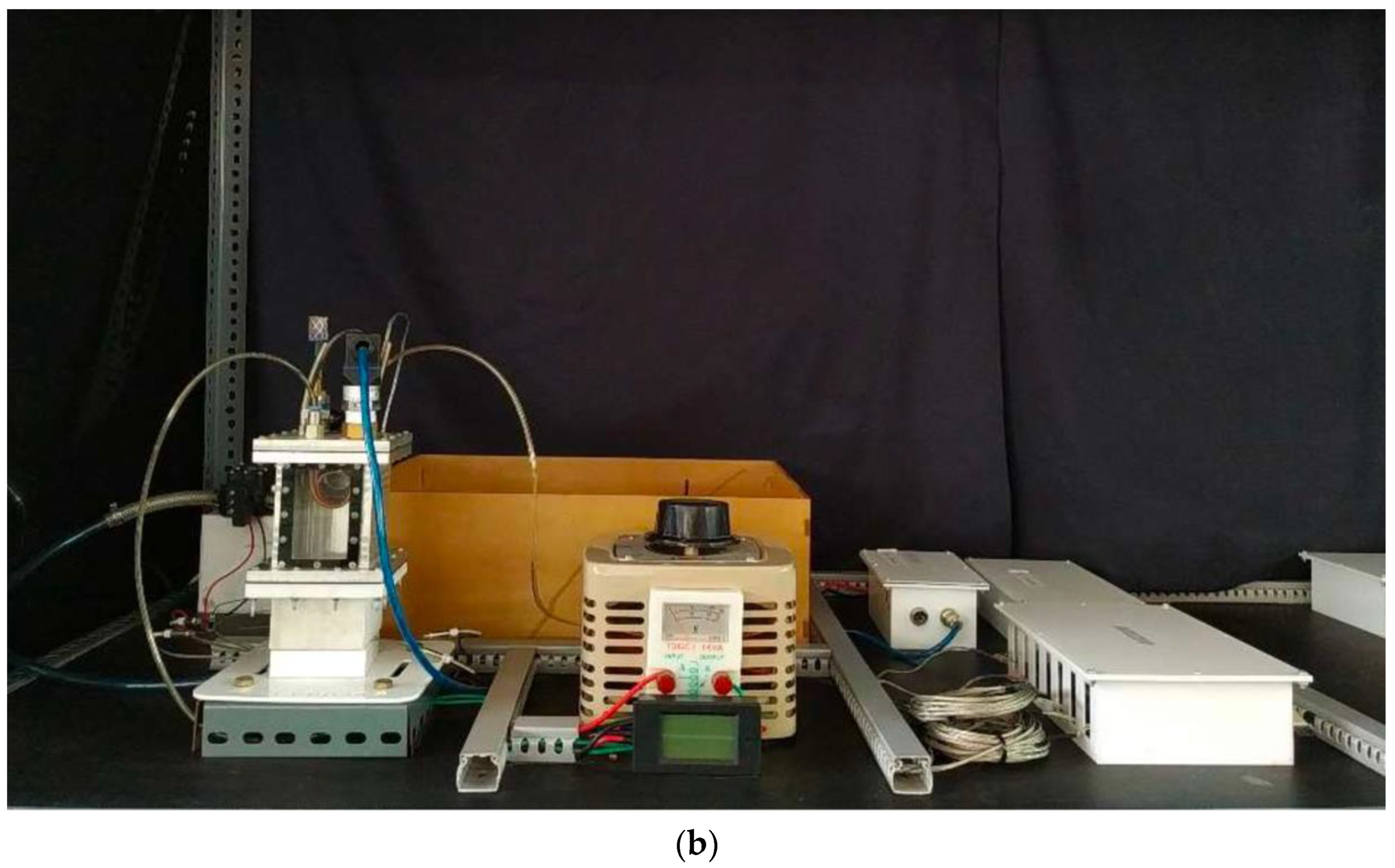

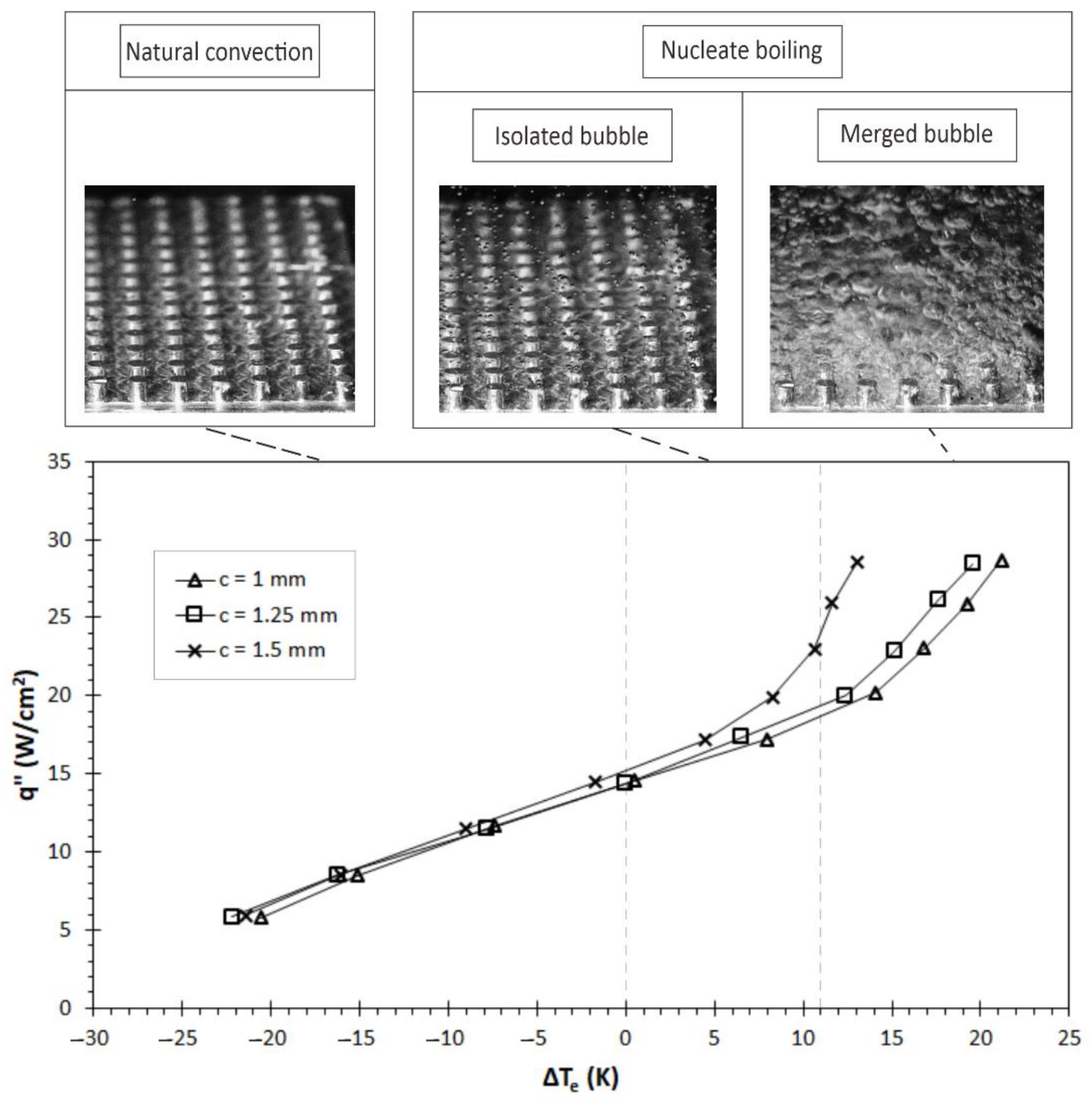
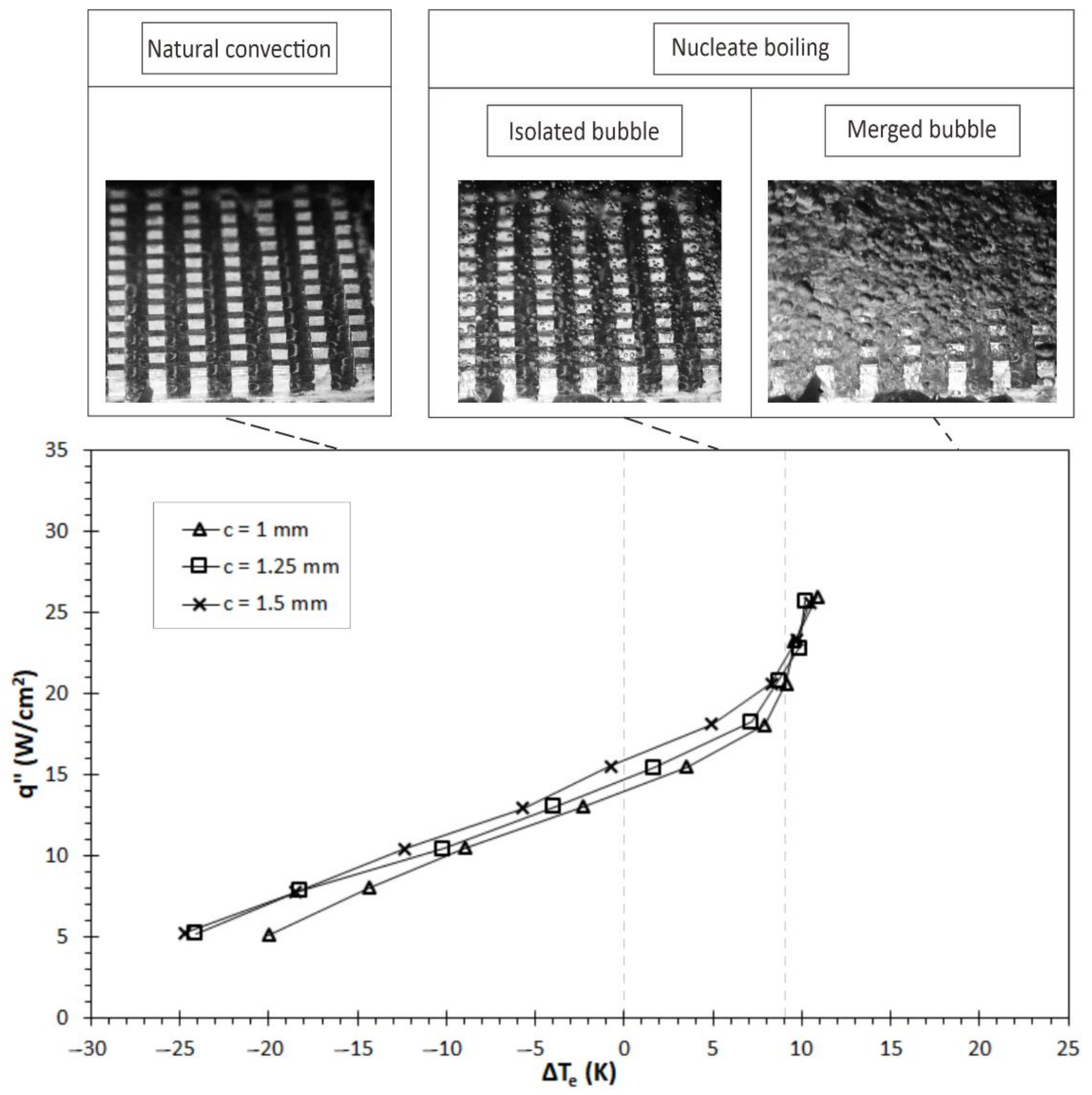

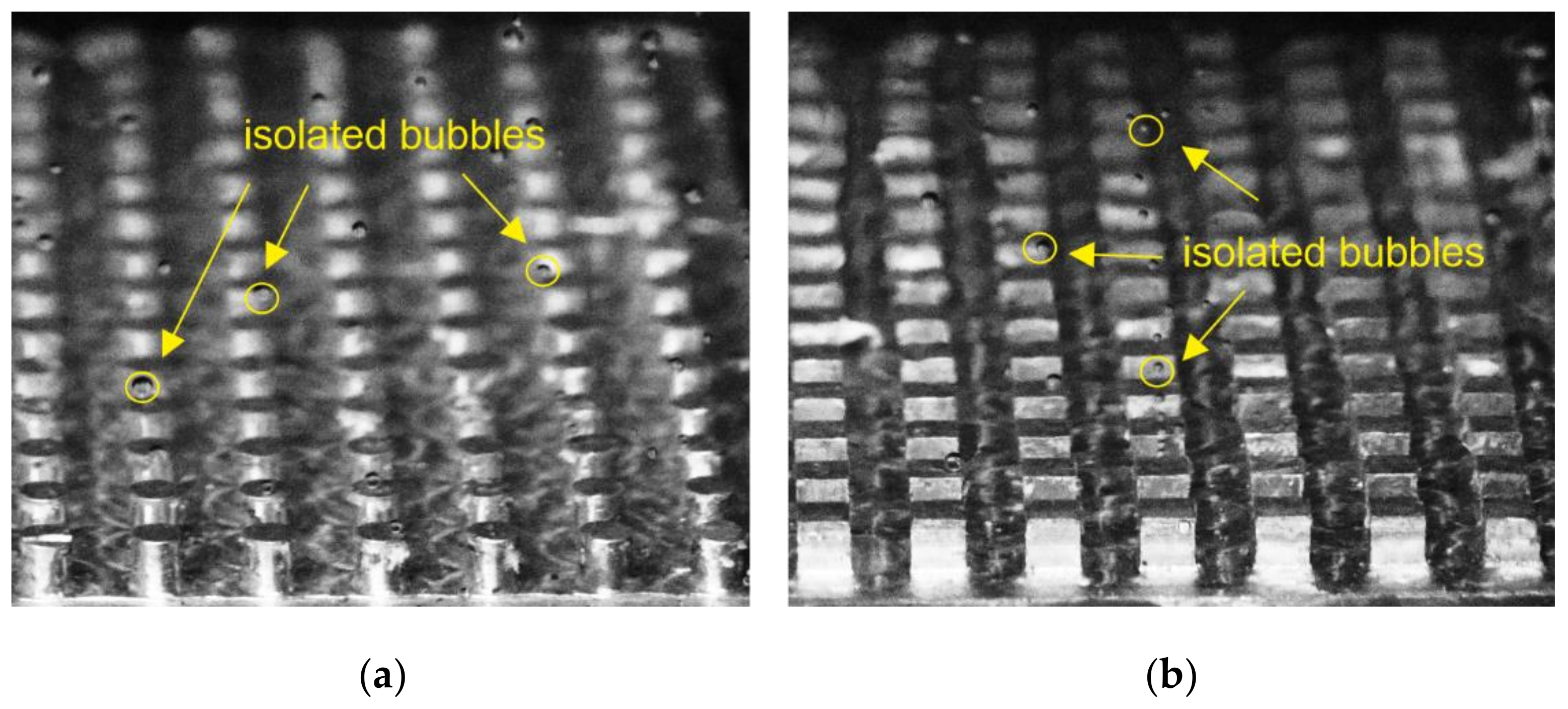

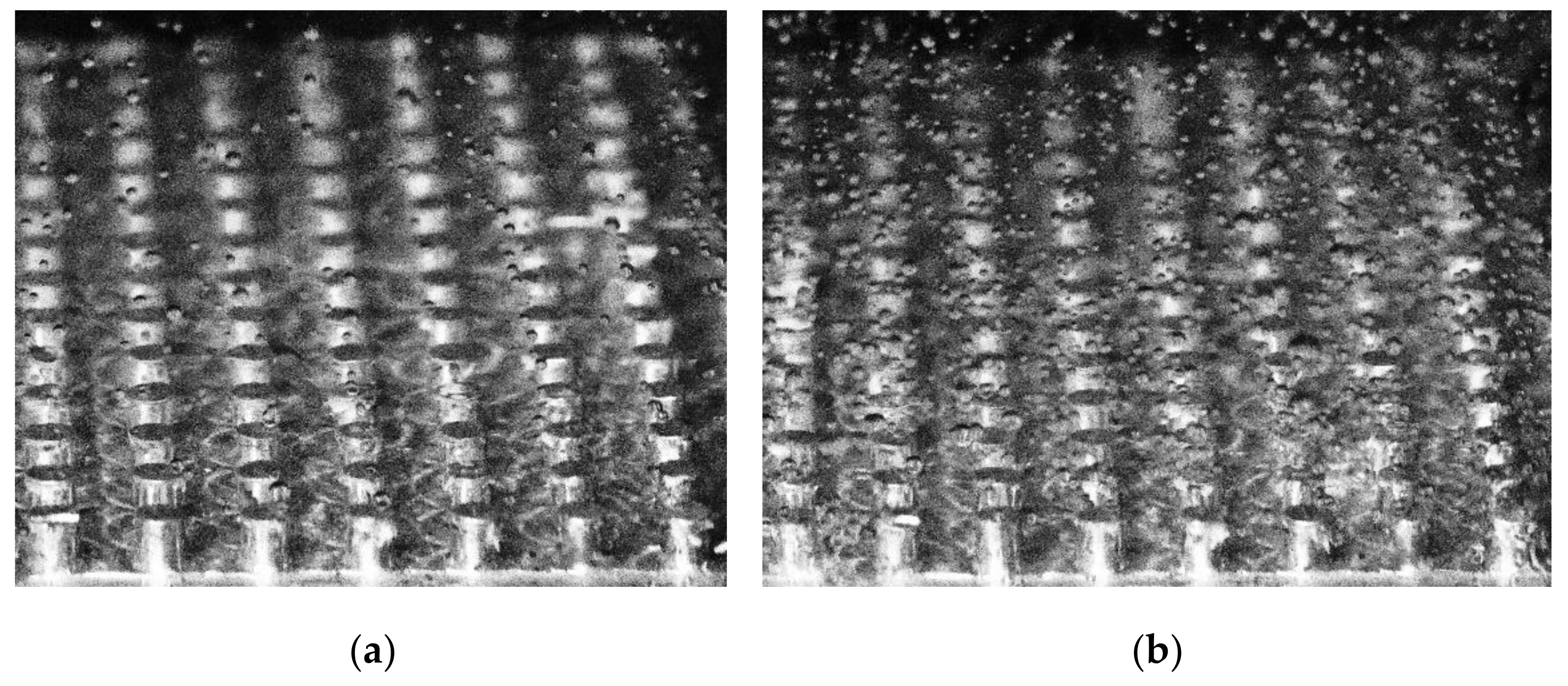
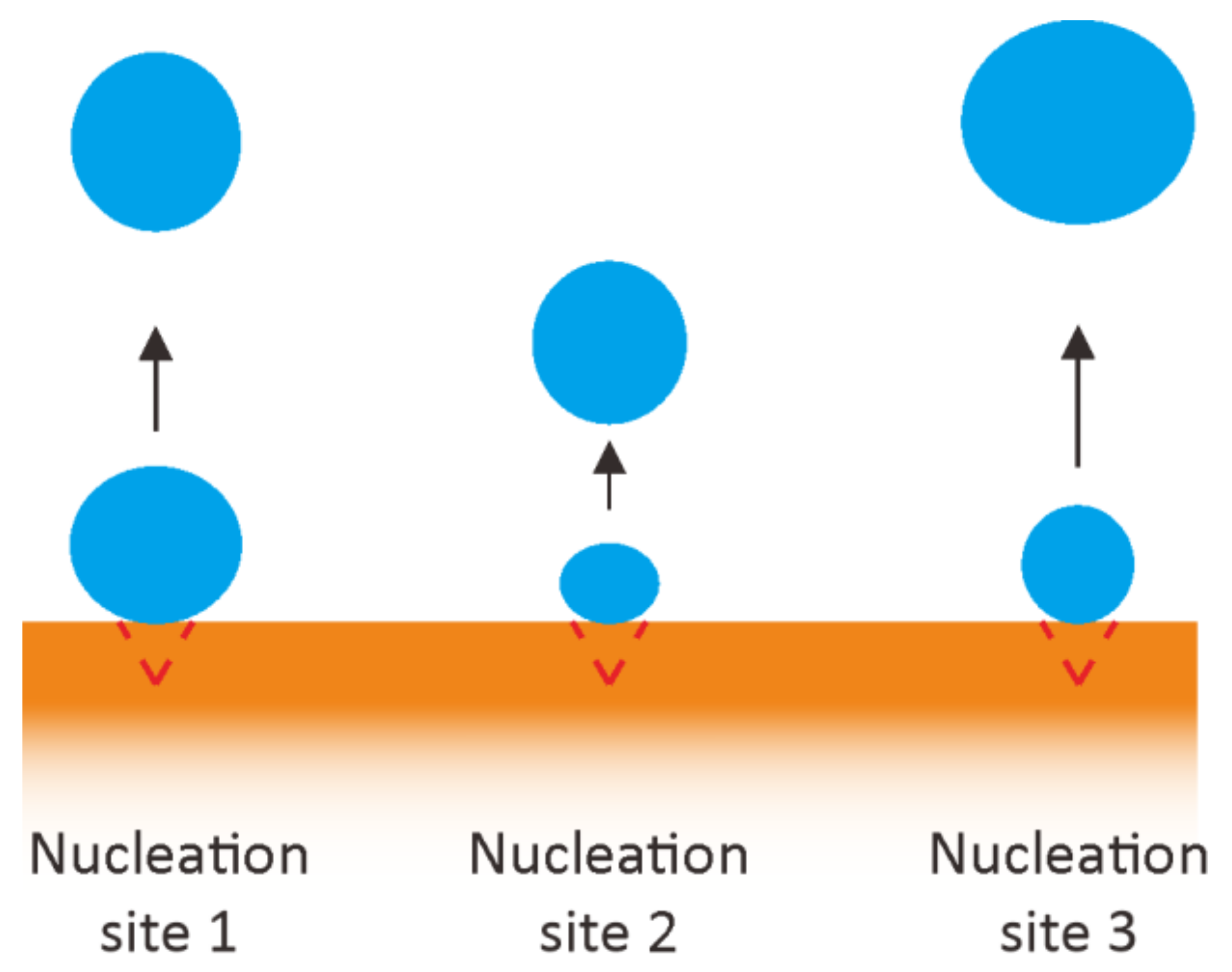
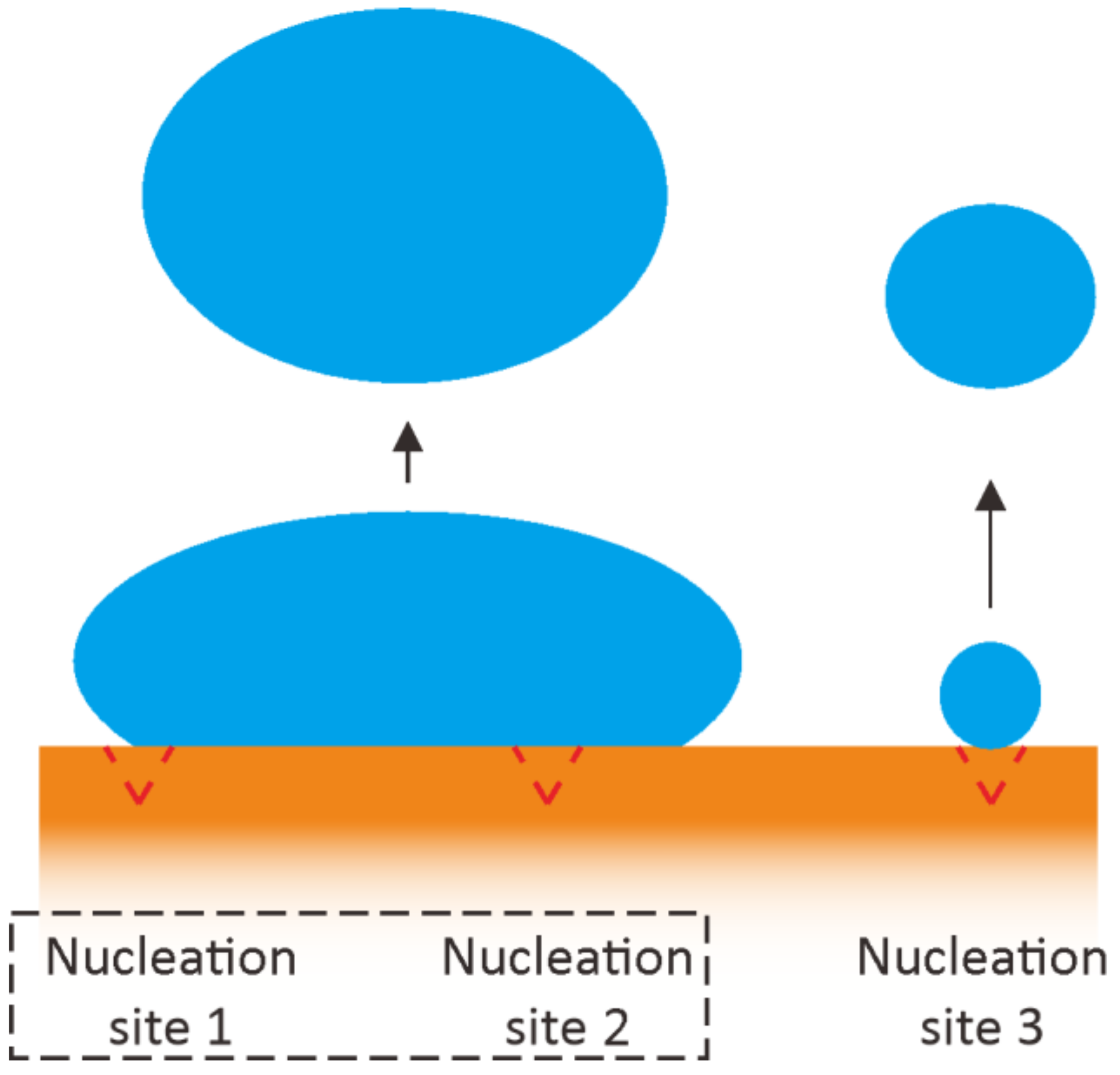
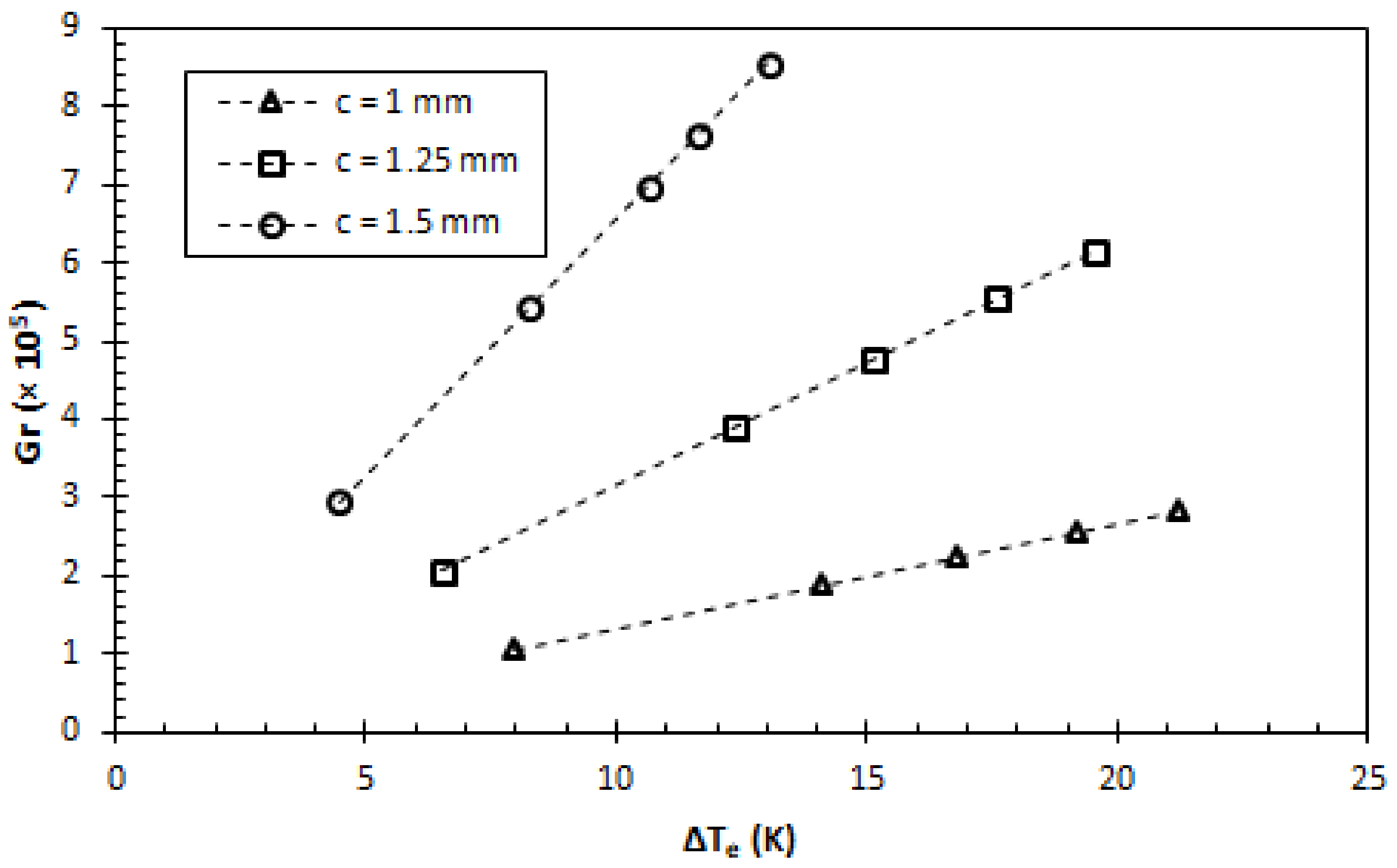
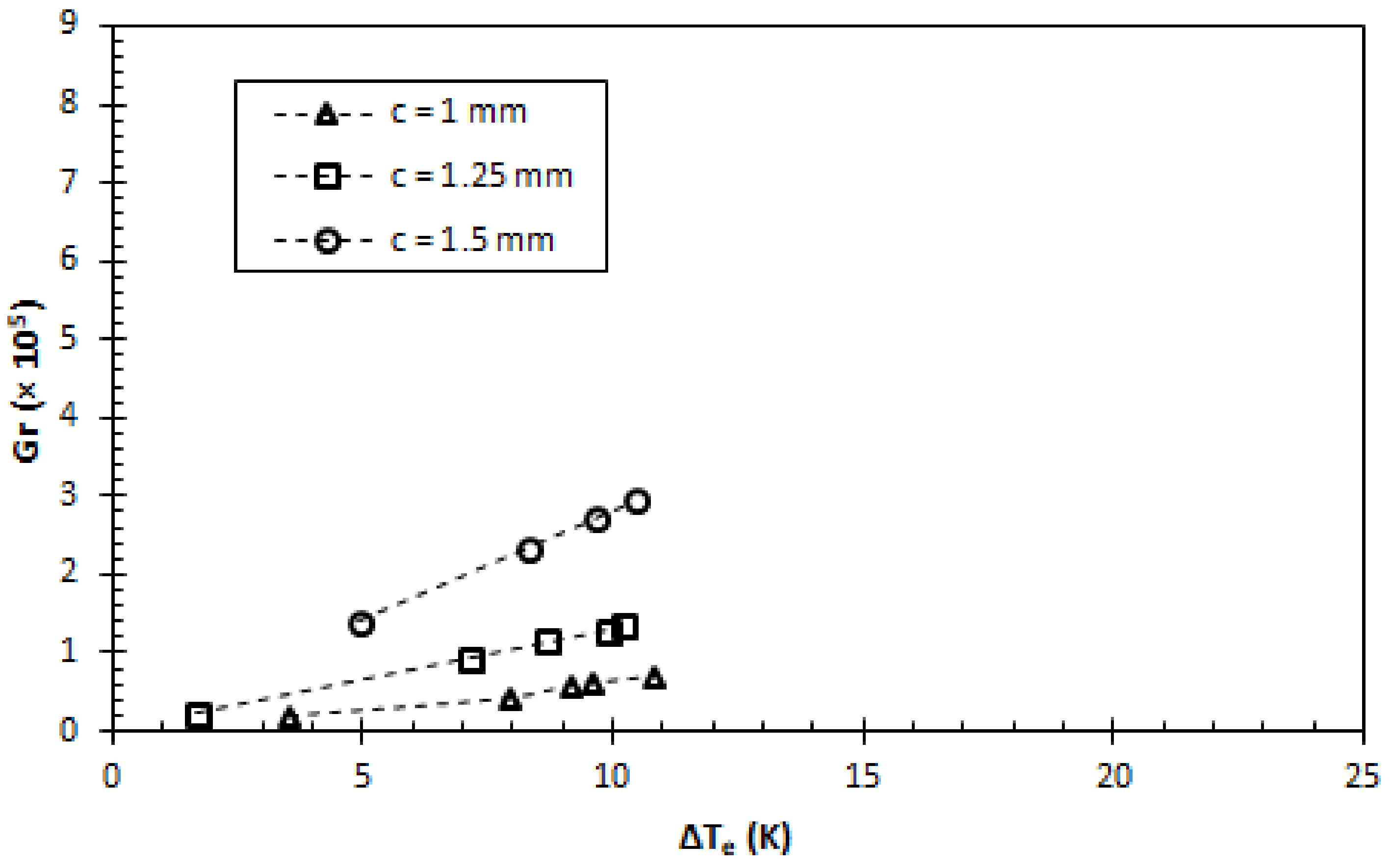
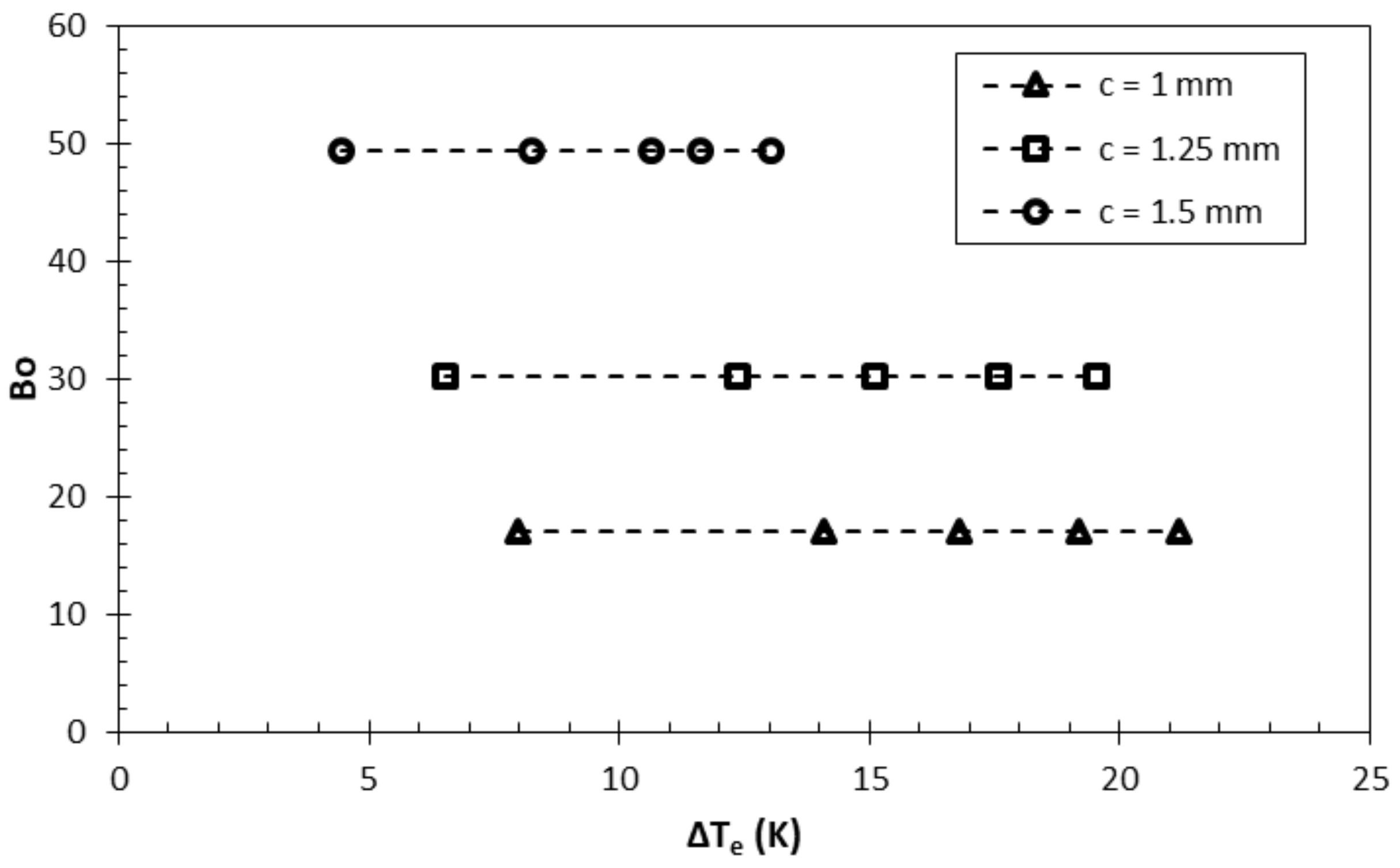

| Test Sample | Pin Fin Shape | Number of Fins | Fin Width (a), mm | Fin Height (b), mm | Fin Gap (c), mm | Dh, mm | Af, mm2 |
|---|---|---|---|---|---|---|---|
| C1 | Circular | 196 | 1 | 1 | 1 | 4.09 | 1516 |
| C2 | Circular | 169 | 1 | 1.16 | 1.25 | 5.45 | 1516 |
| C3 | Circular | 144 | 1 | 1.36 | 1.5 | 6.96 | 1516 |
| R1 | Rectangular | 196 | 1 | 1 | 1 | 3 | 1684 |
| R2 | Rectangular | 169 | 1 | 1.16 | 1.25 | 4.06 | 1684 |
| R3 | Rectangular | 144 | 1 | 1.36 | 1.5 | 5.25 | 1684 |
| Properties | Values |
|---|---|
| Boiling point (K) | 334.15 |
| Vapor pressure (kPa) | 27 |
| Specific heat (J/kg∙K) | 1170 |
| Latent heat vaporization (kJ/kg) | 112 |
| Thermal conductivity (W/m∙K) | 0.068 |
| Liquid density (kg/m3) | 1418.64 |
| Vapour density (kg/m3) | 0.98 |
| Kinematic viscosity (m2/s) | 3.008 × 10−7 |
| Surface tension (mN/m) | 13.6 |
| Thermal expansion coefficient (1/K) | 1.8 × 10−3 |
| Dielectric strength 0.1″ gap (kV) | 40 |
| Pin Fin Shape | Fin Gap (c), mm | Maximum Gr, ×105 | Maximum Bo | Average kW/m2·K | Average | hb Enhancement |
|---|---|---|---|---|---|---|
| Circular | 1 | 2.83 | 17.08 | 13.76 | 1408.55 | - |
| Circular | 1.25 | 6.16 | 30.24 | 15.18 | 1954.74 | 10.3% |
| Circular | 1.5 | 8.56 | 49.39 | 22.50 | 2819.55 | 63.4% |
| Rectangular | 1 | 0.70 | 9.18 | 23.40 | 607.26 | - |
| Rectangular | 1.25 | 1.34 | 16.84 | 24.41 | 906.71 | 4.3% |
| Rectangular | 1.5 | 2.95 | 28.12 | 27.56 | 1736.86 | 17.8% |
Publisher’s Note: MDPI stays neutral with regard to jurisdictional claims in published maps and institutional affiliations. |
© 2022 by the authors. Licensee MDPI, Basel, Switzerland. This article is an open access article distributed under the terms and conditions of the Creative Commons Attribution (CC BY) license (https://creativecommons.org/licenses/by/4.0/).
Share and Cite
Pranoto, I.; Rahman, M.A.; Waluyo, J. The Role of Pin Fin Array Configurations and Bubble Characteristics on the Pool Boiling Heat Transfer Enhancement. Fluids 2022, 7, 232. https://doi.org/10.3390/fluids7070232
Pranoto I, Rahman MA, Waluyo J. The Role of Pin Fin Array Configurations and Bubble Characteristics on the Pool Boiling Heat Transfer Enhancement. Fluids. 2022; 7(7):232. https://doi.org/10.3390/fluids7070232
Chicago/Turabian StylePranoto, Indro, Muhammad Aulia Rahman, and Joko Waluyo. 2022. "The Role of Pin Fin Array Configurations and Bubble Characteristics on the Pool Boiling Heat Transfer Enhancement" Fluids 7, no. 7: 232. https://doi.org/10.3390/fluids7070232





